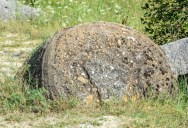Rocks That Move? Meet The “Living Rocks” Of Romania
by Trisha Leigh
It’s not secret that humans are willing to anthropomorphize literally anything. If it appears to have any kind of face or expression we can assign it feelings and a whole personality – and yeah, that definitely goes for rocks, too.
You don’t have to work too hard to imagine these rocks are alive, though, because they actually appear to be just that.

Image Credit: iStock
They reside in the tiny town of Costesti is home to huge boulders that slowly ooze their insides out, and even seem to grow and move…almost as if they were alive.
They’re called “trovants,” but are often referred to as “living rocks.”
Despite frequent interest from both geologists and tourists, no scientific studies on them exist. Some believe they’re sandstone concretions with tough outer layers of sand, making them harder than the rocks around them. When the softer bedrock erodes, they sort of…emerge.

Image Credit: iStock
Like being born, maybe.
As far as the moving and growing, scientists posit that rainwater reacts with the mineral content, causing the insides to slide out. It could also cause bubble-like growths, which can appear like a baby rock next to a parent.
That said, the rocks “grow” quite slowly, expanding around 2 inches in 1200 years, but that doesn’t make them any less fascinating to people like Florin Stoican, co-manager of the Buila-Vanturarita National Park.

Image Credit: iStock
“Their history is rather simple. Seven million years ago there was a delta where the present-day stone quarry is. This delta contained sediments, sandstone, and siltstone in particular, amassed and transported from across the continent by a prehistoric river. Subsequently, various mineral substances dissolved into solutions that circulated over this basin of gravel and sand.”
They might be simple in origin, but their presence today inspires people to ask questions about the earth’s history, about the actions of minerals, and encourages interest in geology – and nothing could be more magical than that.
Categories: NATURE/SPACE
Tags: · living rocks romania, trovants, what are trovants




